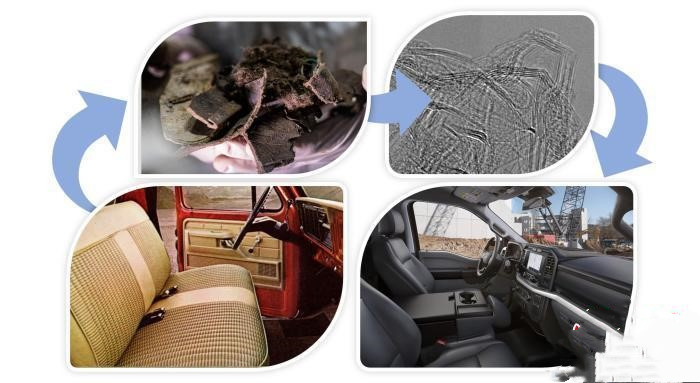Research: Auto waste plastics are cleverly transformed into graphene to promote recycling
China synthetic resin network / Xing Xiuyan / 2022-05-30 15:13:29 5431 0
A paper on sustainability published in communication engineering, an open access professional academic journal under Springer nature, said that a study could turn recycled automotive waste plastics into graphene and use it to manufacture new automotive components through an energy-saving technology. The results of this study provide a potential treatment method for the landfill waste generated by 1.4 billion passenger cars in use worldwide.

The schematic diagram shows the process of cutting waste automotive plastics in the landfill but recycling and upgrading them to graphene (source: Ford Motor Company and Rice University)
The paper introduced that the waste plastics produced by end-of-life vehicles accounted for 1trillion kg of all plastic wastes to be landfilled, with an average of 200-350 kg of plastics per vehicle. For various reasons, such materials are difficult to reuse. For example, many of these materials are engineering transformed plastics, which cannot be recycled; Moreover, the traditional recycling method needs to separate different types of plastics, and the recycling cost is high.
Recent studies have shown that it is feasible to turn waste plastics into graphene. Graphene is a valuable material (worth 60000-200000 US dollars per ton) with high conductivity, high thermal stability, chemical stability and other practical characteristics. This process may be a feasible way to recycle automotive plastics into graphene. Graphene is sometimes used as an additive in some automotive plastics to improve strength and noise absorption.
The corresponding author of the paper, James tour of Rice University and his colleagues demonstrated the use of an energy-saving technology called flash Joule heating to convert used car plastics into high-quality graphene. This technology uses an electric current to heat carbon and turn it into graphene, using only low-cost facilities, without the need to separate or classify plastics, and without solvents, furnaces or water.
The author smashed the bumper, gasket, carpet, cushion, seat and door frame batten of Ford F-150 pickup truck, and demonstrated the general steps of this process. They also used the recovered graphene to strengthen the new automotive plastics, and found that its performance was equivalent to that of the new graphene containing plastic composites put into production by Ford. They then used the Joule thermal flash technology to heat the graphene / plastic composite recovered from the waste again, producing more graphene.
In addition, the author found that compared with the traditional graphene production method, Joule thermal flash technology has lower energy demand, global warming and water consumption. They believe that this research may become a progress towards a more environmentally friendly production mode of graphene.
This article is reproduced from https://www.hongyantu.com/news/29281.html In case of infringement, please inform to delete
A paper on sustainability published in communication engineering, an open access professional academic journal under Springer nature, said that a study could turn recycled automotive waste plastics into graphene and use it to manufacture new automotive components through an energy-saving technology. The results of this study provide a potential treatment method for the landfill waste generated by 1.4 billion passenger cars in use worldwide.

The schematic diagram shows the process of cutting waste automotive plastics in the landfill but recycling and upgrading them to graphene (source: Ford Motor Company and Rice University)
The paper introduced that the waste plastics produced by end-of-life vehicles accounted for 1trillion kg of all plastic wastes to be landfilled, with an average of 200-350 kg of plastics per vehicle. For various reasons, such materials are difficult to reuse. For example, many of these materials are engineering transformed plastics, which cannot be recycled; Moreover, the traditional recycling method needs to separate different types of plastics, and the recycling cost is high.
Recent studies have shown that it is feasible to turn waste plastics into graphene. Graphene is a valuable material (worth 60000-200000 US dollars per ton) with high conductivity, high thermal stability, chemical stability and other practical characteristics. This process may be a feasible way to recycle automotive plastics into graphene. Graphene is sometimes used as an additive in some automotive plastics to improve strength and noise absorption.
The corresponding author of the paper, James tour of Rice University and his colleagues demonstrated the use of an energy-saving technology called flash Joule heating to convert used car plastics into high-quality graphene. This technology uses an electric current to heat carbon and turn it into graphene, using only low-cost facilities, without the need to separate or classify plastics, and without solvents, furnaces or water.
The author smashed the bumper, gasket, carpet, cushion, seat and door frame batten of Ford F-150 pickup truck, and demonstrated the general steps of this process. They also used the recovered graphene to strengthen the new automotive plastics, and found that its performance was equivalent to that of the new graphene containing plastic composites put into production by Ford. They then used the Joule thermal flash technology to heat the graphene / plastic composite recovered from the waste again, producing more graphene.
In addition, the author found that compared with the traditional graphene production method, Joule thermal flash technology has lower energy demand, global warming and water consumption. They believe that this research may become a progress towards a more environmentally friendly production mode of graphene.
This article is reproduced from https://www.hongyantu.com/news/29281.html In case of infringement, please inform to delete





